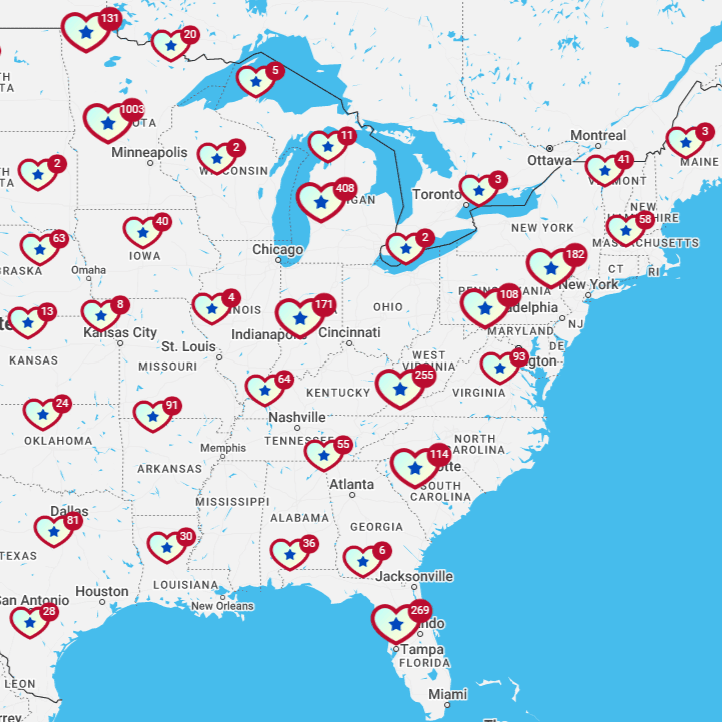
10 Common Myths About Independent Voters
- By the Numbers: Independents in America
- 10 Common Misconceptions About Independent Voters
- Overcoming Misconceptions and Encouraging Civic Engagement
In the duopoly that steers the narrative of mainstream media and American politics, independent voters remain the most misunderstood segment. When they’re not being discounted, they’re blamed for everything from low voter turnout to spoiling elections for the more “deserving” major party candidates.
However, independent voters are steadfast in their defiance of the traditional boundaries of the two-party system, wielding a quiet yet decisive power in shaping the nation's political landscape.
Despite the bias against them, their numbers and relevance are growing.
By the Numbers: Independents in America
Independent voters represent a significant and influential portion of the U.S. electorate. According to Gallup polling from 2023, 43% of U.S. adults identified as independents — a percentage which tied the record high from 2014.
In fact, the upward trajectory of independent identification has mostly remained at 40% or higher each year since 2011. The exceptions are the presidential election years of 2016 and 2020.
This indicates a growing trend of American voters choosing to identify outside of the traditional two-party system.
According to the latest data, the breakdown of independent voters across the United States looks like this:
35.3 million registered voters identify as independents, which comprises 28.55% of voters from states reporting this data.
61% of voters aged 18 - 24 identify as independent.
More than half of Latino voters, 31% of African Americans, and 43% of Asian Americans are unaffiliated with either establishment party
Alaska, Arkansas, and Colorado have surprisingly high percentages of independent voters; the numbers are 62%, 52.5%, and 46%, respectively.
World Population Review recorded more than 5 million independent voters in California, nearly 4 million in Florida , and just under 3 million declared independents in New York. Voters in these key states play a pivotal role in national elections.
Overall, the number of independent voters has consistently outpaced both Republican and Democratic voters since 2004.
This data underscores the significant role that independent voters can play in shaping election outcomes. Yet, independent voters are usually only acknowledged around election time - when an establishment candidate needs their votes - or blamed for election losses when they refuse to toe some party line.
Despite the fact that this trend demonstrates a significant shift in the political landscape away from the traditional two-party system, independents seem to be trapped inside a bundle of misconceptions that we’re on a mission to dispel.
10 Common Misconceptions About Independent Voters
Misconception #1: Independent Means Centrist or Moderate
Media pundits and political strategists tend to lump all independent voters together as moderates who are just rebelling against extremists in the establishment parties. This couldn’t be further from the truth.
Reality: Independents vary widely in their political views, veering from very liberal to conservative and everything in between. This challenges the narrow centrist label that’s pinned on them by political commentators since independent voters display a spectrum of political views.
Examples range from Bernie Sanders, a progressive who has long identified as an independent, to Ross Perot, a Libertarian-leaning business magnate who entered politics by launching the Reform Party. This third party was subsequently helmed by as diverse a selection of indie politicians as consumer advocate Ralph Nader and arch-conservative Pat Buchanan.
Such a wide range of ideologies disproves the assumption that all independents are moderates.
Misconception #2: Independent Voters Aren’t Really Independent
There's a perception that independent voters are simply closet partisans who are just waiting for the right establishment candidate to ignite their passionate support. When push comes to shove, they’ll always fall in line.
Reality: While many do lean towards candidates from the major parties, this is often due to the structure of U.S. electoral politics, not a lack of independent thought. Voting for major-party candidates is often a strategic choice in a predominantly two-party system that places significant barriers in front of anyone running for office as an independent.
This doesn't negate their independent identity; it's simply a pragmatic approach to participating in a system that favors Democrats and Republicans.
Misconception #3: All Independent Voters Are the Same
It’s easy for the media to paint independent voters as a homogenous group of malcontents who just want to rock the boat. However, a deeper look into independent demographics shows us that simply isn’t true.
Reality: This group is incredibly diverse, encompassing a range of ages, races, and beliefs. In fact, the diversity among independents mirrors that of the general population.
Ideologically, independent voters tend to vote policy over party, favoring candidates who prioritize positions that mirror their own values. For example, a young, urban independent voter might prioritize climate change and social justice, while an older, rural independent might focus on fiscal conservatism and traditional values. Both will vote according to their own beliefs.
This range of priorities and backgrounds makes political independents a truly heterogeneous group.
Misconception #4: Independent Voters Are Just Indecisive
There’s a fairly inaccurate image of the independent voter as an indecisive person who just can’t make up their mind between the two establishment candidates. This image doesn’t reflect the reality that such conscientious voters face while attempting to align their values with the available choices.
Reality: Many independents have strong political convictions but choose not to align with a single party. Contrary to popular belief, independents have clear political stances. Their choice to remain independent can stem from dissatisfaction with the binary nature of the American party system or a desire for more nuanced policy discussions that transcend party lines.
Misconception #5: Voting Independent Is a New Phenomenon
Just because a viable independent candidate for a major elected office only surfaces once a decade, and we’re online hearing much about the independent movement lately, that doesn’t mean that independent politics is a new or niche phenomenon.
Reality: Independent voting has been a part of U.S. politics since its inception, so it’s not a modern trend. In reality, independent voters have been influential throughout America’s history. Figures like George Washington even warned against the divisive nature of political parties, embodying the spirit of independent political thought that predates the current party system.
Misconception #6: Independents Don’t Impact Elections
When independent candidates are mentioned at all, it’s usually in the context of also-rans or spoilers. The general consensus is that they can be sidelined or ignored because they really don’t impact elections, at least not positively.
That’s another big misconception about independent voters.
Reality: Independents often play a crucial role in swing states, influencing election outcomes. Independents can sway election results, especially in tightly contested races. In the 2016 U.S. Presidential election, for example, independent voters were a crucial demographic in swing states, impacting the final outcome.
Misconception #7: Independent Voters Don’t Care About Politics
Another common myth about independent voters is that they don’t really care about politics. If they don’t like what the establishment offers, they’ll simply opt out.
Reality: Many independents are deeply engaged and informed, opting for independence to avoid partisan bias. They tend to be politically active and informed, often engaging in issue-based activism rather than party-based performance. In general, independents prefer to focus on specific policy areas like environmental or economic issues rather than aligning with a broad party platform.
Misconception #8: “Independent” Means Unaffiliated With Any Group
One perception of the independent voter is that of a lone wolf who takes pride in going against the grain. This ties into the paradoxical myth of the independent movement as a homogenous collection of malcontents.
Reality: Some independents associate with minor parties or political movements outside the two-party system. They often align with smaller parties or movements that match more closely with their values, such as the Libertarian, Green, or Forward parties. Their independence lies in not aligning with the dominant parties, not in a lack of political affiliation.
Misconception #9: Independents Are Always Swing Voters
There’s a persistent perception of independent voters as swing voters who will switch allegiances and vote on a whim. This is very closely related to the image of the independent voter as indecisive or politically inconsistent.
Reality: While some independents are indeed swing voters, others consistently lean towards a particular party in their voting behavior. This leaning can be based on specific issues or ideological alignment with one party's general stance, even if they don't formally affiliate with that party.
Misconception #10: Independent Voters Lack Political Influence
While it's true that we’ve never had an independent win the presidency, and their numbers are few in the federal legislature, that doesn’t mean they lack influence when it comes to political discourse and engagement.
Reality: Their diverse views and significant numbers make them a powerful force in shaping political discourse and policy. Independents can significantly influence political discourse and policy. For example, their concerns and opinions often influence election-year narratives and can lead to major parties adjusting their platforms to appeal to this diverse and substantial group.
Their influence lies not only in voting, but also in shaping the broader political conversation.
Overcoming Misconceptions and Encouraging Civic Engagement
In 2024 and beyond, independent voters will continue to play a major role in elections at all levels of government. That means it’s essential for anyone who’s serious about running for office to leverage the power and momentum of the independent movement in America.
When planning your campaign strategy, it’s important to authentically:
Embrace and highlight diversity. Independent politicians should actively acknowledge and celebrate the diversity within the independent voter base. This involves tailoring messages to address the varied concerns and priorities of different demographic groups within the independent community. Showcasing real stories from diverse independents can help dispel the myth of a monolithic independent voter.
Educate on independent viability. Combat the misconception that independents aren’t truly independent by educating voters on the nuances of the U.S. electoral system. Highlight how strategic voting within a two-party system doesn’t negate independent thought. Share success stories of independent candidates and movements to illustrate the potential for impact beyond the traditional party lines.
Promote political engagement beyond partisanship. Encourage independents to engage in issue-based activism and community involvement. This approach not only validates their political convictions but also demonstrates that political engagement goes beyond party affiliation. Offer platforms and forums where independents can discuss and advocate for specific policies.
Counter the “indecisive” stereotype with clear policy positions. Independent politicians should articulate clear and well-defined policy positions to counter the stereotype of indecisiveness. By presenting a concise and consistent policy agenda, independents can demonstrate that their political stance is based on informed choices and specific issues rather than a lack of decision-making.
Highlight historical significance. Educate the public about the longstanding tradition of independent voting in the U.S. Share historical examples of influential independent politicians and movements to illustrate that independent voting is not a recent or fleeting phenomenon.
Demonstrate independents’ impact on elections. Use data and case studies from past elections to show how independent voters have influenced election outcomes, especially in swing states. This underscores the power of the independent vote and can motivate more voters to participate in elections.
As the political winds shift, understanding and engaging with independent voters becomes more than a strategy for electoral success. It’s a cornerstone for a more inclusive and representative democracy.
Join the Growing Independent Movement in America
You can become part of the growing independent movement by joining the GoodParty.org family as a volunteer or by running for office in your city or state.
We’re not a political party, but a movement with a mission to break the two-party stranglehold on our democracy.
Photo by Luke Stackpoole on Unsplash



